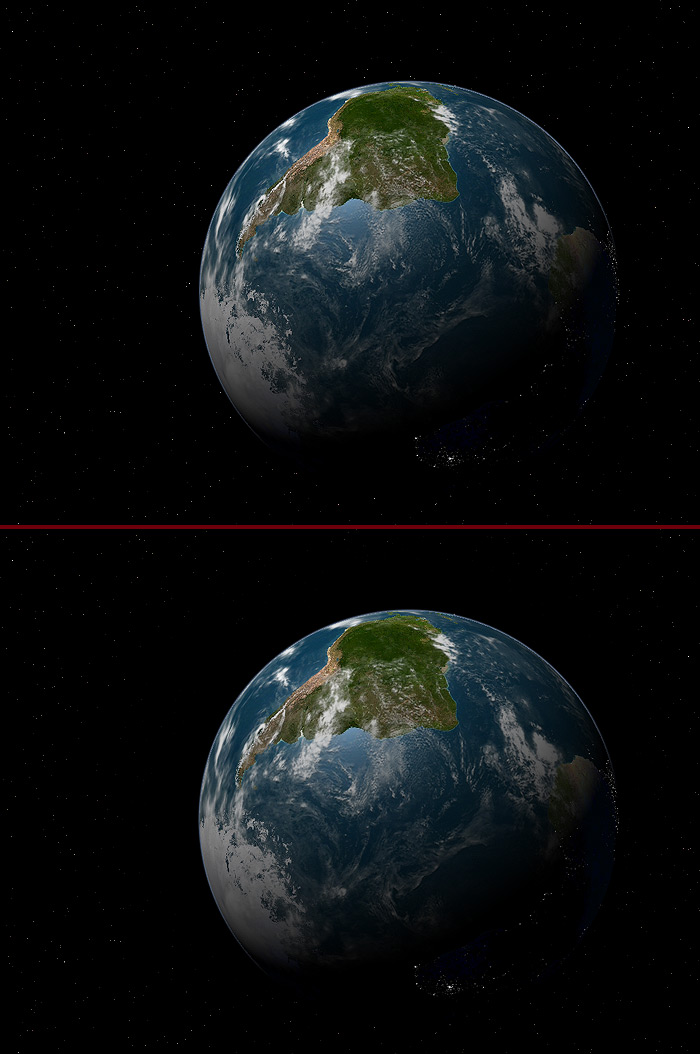let's say I'm at aprox 30000km from earth on my magic carpet; should I see the planet as pict 1 or more like pict 2?


BrainDead wrote:Just a Brain-Dead reply, but shouldn't the stars appear brilliant outside of
the effects of the Earth's atmosphere?
I mean, if there's nothing in the way to block the photons, wouldn't you see
almost every particle of light from the distant stars?
Now you've gotten me curious too. Sorry, can't see any difference in the
Earth itself. Of course, I'm half-blind as well as Brain-Dead too.
Thanks, Bob
hank wrote:My guess is that if the earth is anywhere in your field of view, its brightness will cause your iris to contract, reducing the amount of light entering your eye from all directions. So only the brightest stars would be visible anywhere in your field of view. The effect would not be limited to a band around the earth's disk.
ElChristou wrote:I was thinking in this kind of phisiologic effect; now, someone has an idea on how to implement this?
Perhaps a kind of gradual black filter behind the body, with a size depending on the distance of the observer and always in the axis observer/center of the body?
Perhaps a black halo (as Dirkpitt said)?
It would be nice to do some test to see if the effect can be reproduced...
Malenfant wrote:It's hard to generate the actual brightness of the bright object in the monitor. But I guess you could simulate it by having the stars just either fade a bit as soon as the object is in view, or cut out of visibility completely as soon as Earth enters the view if you're this close.
Cham wrote:Honestly, I don't see how this is related to Celestia. What's the point of having a space simulator which doesn't show the stars !??
I don't want to sound rude, but simulating the human eye response in Celestia is a nonsense to me. Put the ressources on more important things first (there are MUCH more important things to be implemented in Celestia) ! Just my 0.01 cent...
Malenfant wrote:They'd be a bit brighter, but not THAT much - probably not enough to be called 'brilliant'. And they wouldn't twinkle because there's no atmospheric gas in the way.
But yeah, as Hank says, it's about your eyes reacting to a bright light source. In the view in the pictures, you wouldn't see any stars at all (not sure if you'd even see the nightlights for the same reason), and Earth'd be very bright (brighter than the full moon). And anyone who's been out at night when the full moon is up knows how hard it is to see stars around the moon - heck, even in the same half of the sky as the moon?
Cham wrote:Honestly, I don't see how this is related to Celestia. What's the point of having a space simulator which doesn't show the stars !??
I don't want to sound rude, but simulating the human eye response in Celestia is a nonsense to me. Put the ressources on more important things first (there are MUCH more important things to be implemented in Celestia) ! Just my 0.01 cent...
dirkpitt wrote:Is the real reason why I still see stars when I look at Earth or the Sun in Celestia is because my monitor is not bright enough (I'm not "blinded" enough), or are the stars themselves possibly rendered too brightly?



ElChristou wrote:If on day stars are rendered like in those pictures, then a filtering system become almost essential to see flares, spots etc... with this Celestia would gain a really high and impressive level of realism...
Curiosity: are those Nebulae clouds in pict 1 in 3D real time?
Malenfant wrote:A better way to render stars for example would be how the MMORPG EVE Online does it: ...
See how it's just one big bright glare? That's what you should be seeing when you're close to a star. (ignore the nebula clouds etc there). It is certainly possible to SIMULATE the brightness of stars. It's harder to do that with planets without washing out all the features though. But for stars, if you had a glare like this with a washing out of the stars around the light source it'd be a darn sight more realistic.